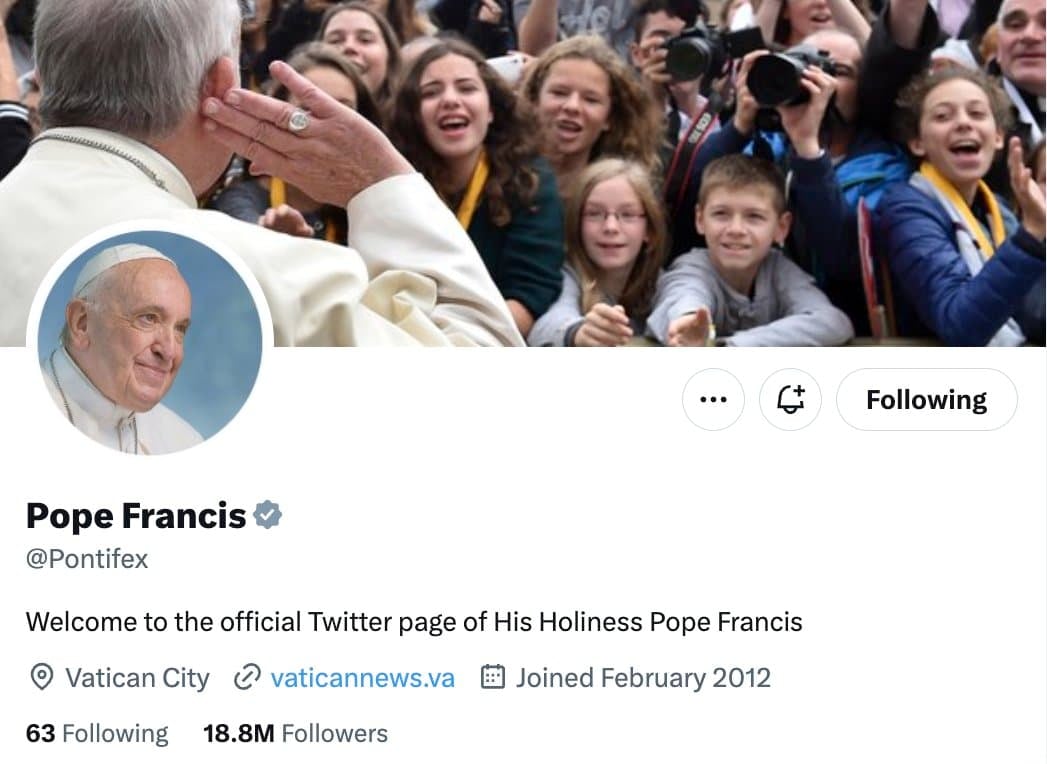
On the very day Elon Musk launched SpaceX rocket Starship on its ill-fated maiden voyage toward space, that final frontier, Musk’s company Twitter did boldly go purging blue verification check marks from users who had not signed up for its paid Twitter Blue service on 20 April, including Pope Francis’ Twitter accounts.
The nine papal Twitter accounts, first set up under Benedict XVI in 2012, tweet a daily message from the Holy Father in English, Spanish, Portuguese, Italian, Latin, French, Polish, Arabic and German.
“(H)e unverified the pope! we’re doing another avignon baby,” quipped Twitter user Anthony Oliveira (@meakoopa), comparing the Twitter CEO’s actions to the 1378-1417 Great Western Schism, when the Catholic Church had at one time three men alleging to be the true pope—one in Rome, one in Avignon, France, and the other in Pisa, Italy.
That papal verification issue was settled at the Council of Constance with the election of Pope Martin V.
“When blue smoke emerges from the Vatican that’s when we know they verified a new pope,” replied Niko Stratis (@nikostratis).
“Counting down the days until mass on Sunday has a second collection for the Pope’s Twitter Verification fund,” said another Twitter user Jim R. Lynch (@JimRLynch).
The Vatican press office, noting that the nine @Pontifex accounts have a total of more than 53 million followers, told CNS Rome on 21 April it understood Twitter was changing some of its policies. But it added, “The Holy See trusts that they will include certification of the authenticity of accounts.”
That same day, following the loss of its blue checkmark, each papal account received a new gray verification checkmark designating “a government or multilateral organisation account.”
The blue checkmark after a Twitter user’s name originally served as a way to let people “know that an account of public interest is authentic,” per the FAQ section of Twitter’s former verification policy. Accounts had to be “authentic, notable and active” and submit specific verification information to fit a specific category of verification.
Twitter introduced the subscription service “Twitter Blue” in 2021, which offered exclusive perks such as bookmark folders and a 30-second undo feature for editing tweets.
Billionaire entrepreneur Elon Musk acquired the company in 2022 and soon after launched an updated version of Twitter Blue that included tweet editing, the ability to upload high-quality video and an identical blue checkmark. In that initial relaunch, many fake yet “verified” accounts abounded and the service was quickly rolled back for tweaks before launching again.
Musk has said that the original way verification was given out was “corrupt and nonsensical” and hinted that non-Twitter Blue marks would soon be removed. On April 11, he announced via Twitter that those legacy checkmarks would finally be removed April 20.
There is now a triad of checkmark colors on Twitter. Blue marks mean an account has an active subscription to Twitter Blue, gold indicates an official business account through Twitter Verified Organizations, and gray indicates a government or multilateral organization. There also are affiliate account badges for each, as well as automated account labels for bots.
To be eligible for a blue mark, accounts must be over 30 days old with a confirmed phone number, have been active in the past month, have a filled-out profile and not be in violation of Twitter’s rules on deceptive, spammy or manipulative activity.
Cost for an individual Twitter Blue subscription is $8-$11 a month in the United States; an organisation subscription has a base cost of $1,000 a month plus an additional $50 a month per affiliated account.
Other religious entities and organisations that have lost their blue checkmark include the U.S. Conference of Catholic Bishops, National Catholic Reporter, Catholic News Service Rome and Protestant televangelist Joel Osteen.
“We did not know the day nor the hour when our blue check mark would be taken away. But it has indeed been removed,” the Reporter (@NCRonline) said in its April 20 tweet.
While not referencing Twitter’s new verification system, the now-bluecheckless Osteen tweeted April 20, “Accept the new thing God is doing. God changes seasons. He closes doors to force us into new opportunities, new growth, new relationships. Don’t get stuck looking back.”
OSV News
